Jennifer Dobson's Blog
October 25, 2020
10 Creative Resources For Landscape Photographers

For ShootingAurora Forecasts

This NOAA website shows a map predicting aurora intensity and locations.
https://www.swpc.noaa.gov/products/aurora-30-minute-forecast
Light Pollution Map
This website shows a map of light pollution around the world so you can plan better star and milky way photography.
https://www.lightpollutionmap.info
PhotoPills App
This app helps you plan photos of sunrises, sunsets, the moon, and milky way, star trails, and time lapses based on time and location.
Sunrise & Sunset Forecasts
SunsetWX
This website has a map that forecasts the most intense and colorful sunrises and sunsets.
SkyCandy App
This smartphone app predicts your chance of a colorful sunset or sunrise based on location.
Drone Laws
This website curates drone laws for different locations around the world.
http://droneownersnetwork.com/worldwide-flight-rules-drones/
For EditingLens Distortions
The Lens Distortions app lets you add light leaks, sun flares, fog and bokeh from your smartphone.
https://lensdistortions.com/mobile/
Photo editing
Adobe Lightroom App
The Lightroom App lets you make adjustments to expsoure, shadows, highlights and more from your phone instead of a computer.
https://www.adobe.com/products/photoshop-lightroom.html
Snapseed App
This app lets you make adjustments and edits to your photo from a smartphone.
https://apps.apple.com/us/app/snapseed/
Presets and filters
The VSCO app lets you add different filters and presets to your photos from a smartphone.
About Jenny
I’m an INFJ, writer, photographer, coach, and author. I created this blog to inspire and motivate creative introverts to trust their intuition, follow their passion, and live a life worth writing about. If you’re interested in working together I’d love to help. Email me and let’s talk.
October 19, 2020
Muse Medicine: How to Rekindle your Creative Spark

Creativity is a magical force that is difficult to harness. It’s a constant source of inspiration, but the harder we try to finish our creations, the harder it is to find our creative flow.
That pressure is stifling to creativity and in trying to force the completion of a project, we actually push that creative spark farther away.
Our world today revolves around masculine energy and getting things done, but creativity needs feminine energy to succeed. This energy has nothing to do with being a man or a woman, but the different sides of our brain we use for different tasks.
Feminine energy is loose and uninhibited. Its ebbs and flows. It’s intuitive and irrational without any care for success or results. When we let go of all expectations and just let our creativity flow, we remove resistance and nurture the energy we need to tap into our true creative potential.
Here are my top tips for tapping into your feminine, creative energy and finding your muse with more flow and ease.
There are times when you need to re-tailor an ill-fitting life. These are the times that will define you—the moments you seek out your dragons and slay them when they rise. This is the courage to be creative
— James Victore
Create for no one
Create something for your eyes only without caring about the final result. Setting the intention of throwing it away or storing it out of sight gives you permission not to worry about making it perfect, or even good. Another way to approach this is by trying to intentionally create something bad. This makes the activity fun and completely removes the self criticism that comes from trying to make something look the way you envisioned.

Go analog
Technology is a gift that can help us with our creations, but it can also interfere with the creative process especially if you have notifications, multiple tabs open and other distractions while you work online. Think about how writers used to work from typewriters. When you write on a computer you have the option of stopping to watch videos, check emails, or scroll social media but a typewriter is designed for only one thing- writing. Even if you need technology for your specific work project, it’s still helpful to practice an activity like writing in a journal or drawing to create without the use of a screen to reset your creative energy.

Rotate projects
This goes against the common advice of focusing on one thing at a time, but for many creatives, this advice just doesn’t work. Being creative means we have a constant flow of new ideas and it’s almost impossible to pick just one of them. Stop resisting this “shiny ball syndrome” and give yourself permission to work on multiple things in a rotation. This way, when you get blocked or stuck on one project, instead of procrastinating, you can just work on another project until your inspiration is refueled.
Feminine energy doesn’t follow a linear path and creating with feminine energy means going where the path takes you without knowing the destination. Sometimes, you just won’t be able to see the next step on a project or you will feel too much resistance around it, and that's ok. With time and space, the energy will probably shift or new ideas will come to you and you’ll be ready to come back to the first project.

Protect your ideas
Ideas are most fragile when they’re new. Creative people, especially empaths and intuitives, can be hyper-sensitive to criticism even if it’s constructive. By sharing an idea too soon the energy around it can fizzle out before you really get started. Protect the energy around your creative projects by keeping them private until you’ve been working on them a little while.

Plant seeds
Do you have more ideas than you know what to do with? Creative people usually have no shortage of ideas and that's ok. Our ideas are like seeds and some take longer to sprout than others, some die before they finish growing, some turn into a big tree and some turn into small flowers. We have a constant cycle of things growing and dying at all different speeds. Accepting and recognizing that will allow you to embrace the creative process and be more patient. You can’t force a project to grow faster just like you can’t force a tree to bear fruit. Just keep tending to your ideas until they’re ready to be harvested in their own time.

Say Goodbye
When we finally do finish that project, it can be confusing to feel depression instead of excitement, but it’s totally normal. We’ve been nurturing and growing this idea for so long, like raising a baby animal, and now it’s released into the wild and doesn’t need us anymore. It’s like saying goodbye to a friend that’s been keeping us company on a journey. It’s important to pause and take a break to lean into this creative depression by being gentle with yourself. Give yourself at least a few days, but even weeks or months to really grieve and say goodbye, or however long you need to feel rested and reinspired.

Trigger a flow state
A flow state is a feeling of complete focus where time falls away and you are absorbed and completely present in the task at hand. Your inner critic and ego disappear, the work becomes effortless and everything just clicks. There’s a lot of complicated neuroscience behind it, but the important thing is that certain activities can help nurture and trigger flow states more often.
One example is seeking out novelty in your environment, which can be as simple as working outside or in front of an open window where the breeze, light, and sounds are always changing.
Another thing you can try is creating a trigger. By starting work the same way each day, you can hack your brain into work mode by queuing yourself with the trigger over time. I listen to the same song on repeat when I’m doing important work and it helps me get into a trance-like, concentrated state of flow. Think of lullabies for children, by singing them the same song at bedtime, they associate this song with feeling sleepy, and eventually, the song can help lull them to sleep. This is designed to work the same way.
Taking emotional risks is another way to nurture flow. For creatives, this can mean sharing your work with the world in spite of feeling shy of self-conscious.
Flow states can also be triggered by combining multiple ideas into something new which is something creative people really excel at.
Working in a group of other people who are all focused on a common goal is another way to trigger flow. Silent writing groups are a great example. I will also be hosting virtual co-working groups for members of my Facebook group.

Create a ritual
For many people, creativity peaks first thing in the morning and there’s also evidence that the first 90 minutes of your day are the most important. Try to avoid screens for the first few hours of your day if you can, especially on any day you want to devote to creative projects. Listening to music and cooking breakfast are great ways to kickstart your day because they involve creativity, but not any screens. My favorite way to start the day is with a cup of tea and a book.
You might feel most creative in the afternoon or late at night so just find what works for you.
No matter what time of day works best, try to create a ritual that nurtures your mind, body, spirit and overall wellbeing. Some options include exercising, mindfulness or meditation and listening to binaural beats or chakra frequencies. Sleeping well, eating well, staying hydrated and taking care of your mental health can be incorporated into your routine and will feed your creative energy.

Get rid of your to do list
The never-ending to do list will always make you feel like you haven’t gotten enough done, and that frustration stifles creativity. I still keep a list of everything I want to get done, but I don’t look at it until I'm done with my creative work for the day. I’ve also stopped treating my tasks like a to-do list, and more like a menu. I just choose what I feel most compelled to cross off that day, and I don’t worry about due dates for anything unless it’s really urgent. I also set intentions (like do something for my body 6 times this week, do something for my mind 6 times, and do something for my soul 6 times), in place of specific tasks. This is a great way to get things done in a way that feels more relaxed and less like a chore.

Get rid of due dates
One problem with to-do lists is that you never know how long something should take, especially if it’s something creative you’ve never done before. As perfectionists, finishing a project can stretch into eternity because we’re never really happy with the final result. Instead, think about how much time per day or week you want to spend working and craft your lifestyle around that. A good rule of thumb is 2 hours of screen time per day if you can manage it.
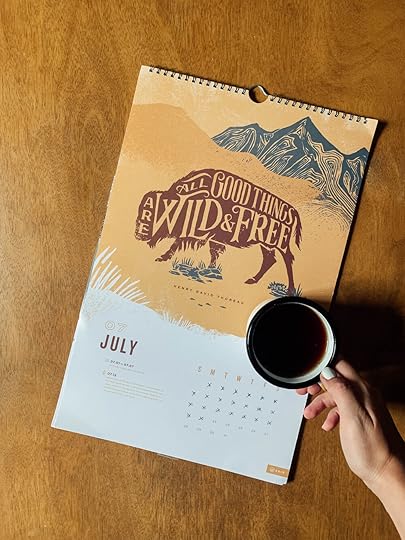
Give Yourself A Magic Hour
Many people feel like they need to create all day every day, but that can stifle your inspiration and enfuse your work with stressful energy. Just one hour per week can be an easy way to feel like you’re giving your project the attention it needs without burning you out, especially if you have other responsibilities or a full-time job. You’ll be surprised how much you can accomplish in just one hour of truly focused time, but you don’t have to stop there. If you’re still in the mood to keep working after that, keep going. Timers or silent writing and co-working groups are a great way to hold yourself accountable and get your project finished.

Get rid of anxiety
Anxiety is paralyzing and many highly sensitive creatives suffer from it. Creating from a place of anxious energy can hinder your creative flow and make your project feel more like work and less like art. Once we start paying closer attention to our emotions, it’s easier to realize when we’re anxious and figure out why. Try to recognize when you’re feeling stressed and take a break until you’re feeling positive. By working from a happy mental state, your work will feel more fun and that energy will be infused into your finished product.

Join a silent writing or coworking group
Silent writing groups are great for getting work done. Somehow sitting down with others who are all working towards a common goal helps tune out distractions and hone your focus. These groups are held both in person and online. To join my online co-working group, subscribe to my email list and look for an invite in my Facebook group. The best thing about these groups is that there’s no critiques. For highly sensitive creatives, any type of criticism, even constructive can completely kill our motivation.
Would You like To meet other like-minded creatives?
Opt-in to my email list for an invitation to my private Facebook Group
Email Address
Sign Up
We respect your privacy.
Thank you!

Take risks and be vulnerable
You can’t selectively numb emotion. When you numb pain you also numb joy, and in this way being vulnerable is key to living a happy and fulfilled life. When we’re vulnerable and face the pain of rejection, our work is infused with real, raw emotion that will help people in our audience really connect with it. Really any form of art, art from music to dance to photographs and paintings are all about evoking emotion so the more vulnerable you are with your work, the more of that emotion you are putting out into the world. Vulnerability is what helps us connect with others and is often a key ingredient in our best most impactful work.

Embrace Your Subconscious
Creating mean you need to be actively working on your project. Sometimes our best ideas come to us when we let our mind wander instead of intentionally trying to think through our next move. Let your subconscious work on problems for you by taking a break, listening to music or going for a walk in nature. Don’t think of these as indulgences but necessary homework to nurture your creative process. Journaling about your problems before bed is another trick that can help you wake up with new solutions.

Create first, Edit second
Creating things uses our left-brained feminine energy while editing uses our right-brained masculine energy. Trying to use both or flipping back and forth can actually suffocate your creativity and tunes out your intuition. When you’re writing, for example, it’s hard not to edit as you go or pause to Google the right word. Instead, just keep writing without stopping, without going back and reading what you’ve written. After you’ve brain-dumped everything you can go back and start editing. This way, you are leveraging both types of energy for their maximum effect. I write all of my blog posts this same way.

Use a timer
It can be almost impossible to guess how long a new creation will take, and setting due dates that come and go can have a negative effect on our mindset. Creatives are often perfectionists, too and it may feel like some projects are never perfect enough to be finished. Instead, decide how much time you want to spend working per week or per day and set a timer. I love using a pomodoro timer for 25 minutes at a time because it’s been proven that we work most efficiently in 25 minute increments.

Before you start replying to emails or scanning your to-do list, pick the one thing that's most important to your creative journey and do it! As mortal humans, our ability to make good decisions over the course of our day deteriorates every time we have to think through a problem, called decision fatigue. Every time we have to think about how to reply to an email or what to comment on a social media post, we are draining our creative juice and taking that energy away from the projects most important to us.

Many creatives have a habit of focusing on our completed vision instead of just the next step. This can trigger anxiety if it feels like our project is taking too long, or if we’re afraid of putting it out into the world, or we’re anxious about how much money we can make from it. Try to scale down your focus to just what you can accomplish this month. If that’s still overwhelming, just focus on this week, or just this day, or even just the next hour. Cutting out distractions, doing one thing at a time, and not worrying about the end goal will make your creative journey feel more enjoyable and less like a struggle.

Hone Your Intuition
Creating is an intuitive process, but as children many of the most weird, unique and magical among us have been taught not to trust our gifts, to draw inside the lines and to approach everything with logic. You can practice reconnecting with your intuition by embracing spontaneity and trusting your gut. For example, go for a drive without knowing where. Just drive whatever direction that resonates with you the most. Draw without knowing what, just start making lines and see what shapes emerge. Write your thoughts in real-time as a stream of consciousness. By feeling through fun, low pressure activities you can start learning to trust your gut and recognize relaxation or resistance in your body.
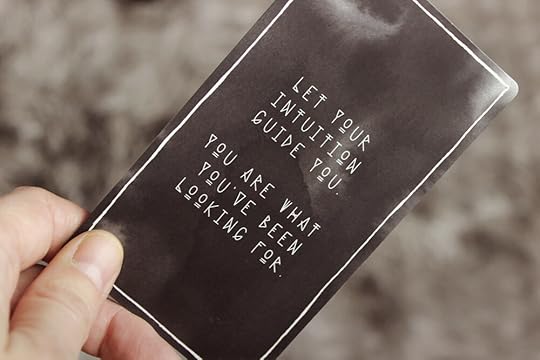
If you’re struggling to tap into your creativity, consider letting go instead of pushing harder. Think of your art as co-creating with the universe where you are a vessel allowing insights and intuition from your subconscious to come to the surface in their own time.
I know this can be difficult because you have goals you want to reach as quickly as possible, but I think you will find that by removing structure like due dates and “shoulds” and “have to’s” that your projects still get done, they will feel more enjoyable and things will just start to feel like they’re magically coming together.
You don’t need to feel like you’re always swimming up-stream. Just trust your creative intuition to carry you where you need to go because that’s what the essence of creativity is all about.
Actionable StepsCreate for no one
Make something to hide or throw away
Make something bad on purpose
Go analog
Work offline
Rotate projects
Protect your ideas
Don’t share anything that’s too new
Plant seeds
Don’t rush projects
Don’t force yourself to complete projects
Say Goodbye
Take pauses in between projects to reset
Trigger a flow state
Seek novel environments
Start work with a trigger
Share your work
Combine multiple ideas together
Work in a group
Create a ritual
Do something creative first thing in the morning
Find a routine that nurtures balance
Get rid of your to do list
Keep your to do list hidden
Set intentions instead of tasks
Get rid of due dates
Set a daily time limit for work
Give yourself a magic hour
Set aside one hour per week for your project
Get rid of anxiety
Stop when you feel stressed
Join a silent writing or coworking group
Take risks and be vulnerable
Tap into your emotions
Embrace your subsconscious
Take a break
Journal your problems
Create first, edit second
Use a timer
Pick one MIA (most important action) per day
Focus on the present
Hone your intution
Make spontaneous decisions
Create without costructs
Book RecommendationsThe following links are affiliate links. If you make a purchase, I will get a small affiliate commission at no extra cost to you.
Creative Calling by Chase Jarvis
Steal Like An Artist by Austin Kleon
Daily Rituals: How Artists Work by Mason Currey
Resources MentionedPomodoro Timer: tomato-timer.com
About Jenny
I’m an INFJ, writer, photographer, coach, and author. I created this blog to inspire and motivate creative introverts to trust their intuition, follow their passion, and live a life worth writing about. If you’re interested in working together I’d love to help. Email me and let’s talk about your current challenges.
October 4, 2020
10 Ways For INFJs To Travel Happier
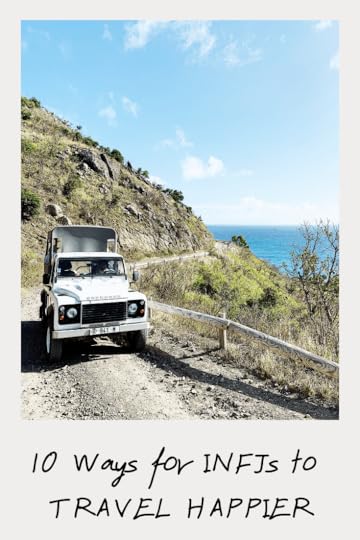
Last year in 2019, I rediscovered my INFJ personality type and it’s helped me understand and accept myself in such a productive way. As the rarest type, I always felt like a misfit in a world that didn’t understand me. Having my thoughts and feelings validated in a way I could never articulate was empowering and helped me to finally feel less alone.
INFJ is one of 16 personality types identified by the Myers-Briggs Type Indicator (MBTI) personality assessment. Each letter represents a preference for how you interact with the world with INFJ representing Introverted, iNtuition, Feeling, and Judging. Alternative combinations include Extroversion, Sensing, Thinking, and Perceiving.
INFJs account for only 1-2% of the population, and as a result, we often feel alone, weird, and like we don’t fit in. As introverts who rarely interact with strangers anyway, we become even more isolated and alone because of those limited opportunities to meet people who really understand us. But the truth is, INFJs have a wild, adventurous, (and even twisted) side that most people rarely get to see. That often includes a love of travel.
We are seekers who want to understand the world, the people around us, and even ourselves on a deeper level. Travel forces us to be vulnerable and present in the moment in a way that delivers those connections we’re always craving. It’s almost like our lives are stories, and exploring outside our comfort zones sparks adventures and character developments we couldn’t have written sitting at home.
Travel is a powerful teacher. It helps us face our fears and overcome our anxiety by reminding us that most people are good, the world isn’t that scary, and when we do finally leave our cozy nooks for the wild unknown, magical things can happen.
Click to tweet
As an INFJ with a love of exploration, I wanted to share my favorite introvert-friendly travel hacks so you can feel less overwhelmed and ever ready to write your next adventure.
..The vagrant owns the whole vast earth that ends only at the nonexistent horizon, and his empire is an intangible one, for his domination and enjoyment of it are things of the spirit.
― Isabelle Eberhardt, The Oblivion Seekers
...
Stay Somewhere CozyINFJs want to feel at home, even when we’re away from home. I love Airbnbs because they have a cozier feel than a hotel, and it supports the local economy instead of a big hotel chain. You can use the filters on the Airbnb website to find lodging with a full kitchen, washer, and dryer so you have every comfort you would have at home.

As introverts with an extroverted side, we still like to have some human interaction when we feel up for it. By booking a private room in a shared Airbnb or even a hostel, you can have the best of both worlds and choose when to interact with people. Just look for places with good reviews. Airbnb also has a “Superhost” search filter that will connect you with hosts who go the extra mile for their guests and are usually great resources for local travel tips.
I’m a big fan of Airbnb because it’s allowed me to travel full-time for almost a year now.
If you’re not on Airbnb already, you can use my affiliate link for up to $65 off your booking.
You don’t have to use Airbnb, though. There are lots of creative ways to find lodging including bed and breakfasts, pet sitting jobs, home exchanges, furnished sublets, and coliving spaces.
Travel Slow
INFJs like to make deep connections with places and people. We don’t want to do the generic, touristy stuff. By staying longer in one place, we can create a routine that makes us feel comfortable and at home while experiencing the area like a local.

My advice for traveling slowly is to book an Airbnb for a month or more. Some Airbnbs give monthly discounts so a 1 month rental can actually end up being cheaper than 2 or 3 weeks.
If Airbnbs in your destination are overpriced, check their competitor VRBO (Vacation rentals by owner). Another great option is Landing apartments. This company supplies a network of fully furnished apartments without long-term leases in popular cities around the US.
You can also offset the cost of monthly rentals by splitting the rent with friends.
One challenge with long-term travel is that many people (especially Americans) only get 1-2 weeks of vacation per year. If you’re not allowed to work remotely and you’re interested in working for yourself and having more control over your time, I have a book and a course that teaches creatives how to start freelancing like me.
No matter how long you’re traveling, try to include “buffer days” before or after your trip if you can. One or two days off at home can be really helpful in preparing yourself for your trip or adjusting to your return.
Live Like A Local
When you first arrive at your destination, exploring the neighborhood around your home base is a good way to get oriented and comfortable in your surroundings. A simple walk or a drive can be great for this, or you can look for nearby bus, bike, and walking tours. If I’m near the water, I love riding the ferry or water taxi around just to get a feel for the area.

Avoid touristy, over-priced experiences by seeking out more intimate options. Airbnb Experiences offers activities hosted by local experts in small group settings.
There’s another service called couch-surfers where travelers can look for free, rudimentary lodging. While I don’t recommend couch crashing for INFJs who need more comfort and space, they also have an events section. If you’re in the mood to socialize, this is a great way to meet other travelers and like-minded friends.
Meetup.com is a good option for meeting locals with similar interests. It lets you search for nearby events and groups based on your favorite hobbies.
Hostels can be a great resource for local events, or even just a nice place to sit and read a book or drink coffee. I used to attend a silent writing group at my local hostel and I loved the opportunity to do something solitary while still being around interesting people.
Try Glamping
Glamping is the art of upscale camping (glamorous camping) that includes extra amenities and services beyond just a tent space and a bathhouse. INFJs love spending time in nature and it’s one of our favorite ways to recharge, so glamping is a great way to spend time outdoors but still feel like you’re on vacation. Through sites like Glamping Hub, HipCamp, Under Canvas or Airbnb’s “unique stays” filter, you can find all kinds of awesome options like yurts, tipis, canvas tents, and treehouses.
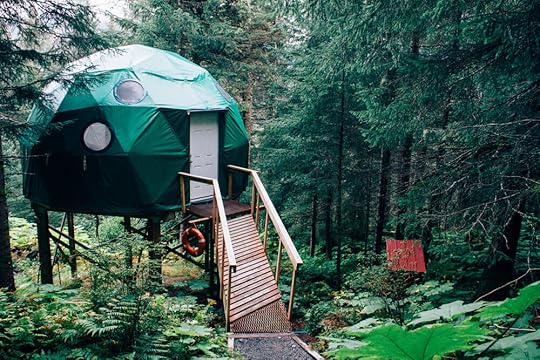
Go On A Road Trip
Road Trips can be a great way to wander across your own country or somewhere new. I love road trips because it gives me the chance I need to stop overthinking, turn on some music, roll down the windows, and just enjoy the view. Some of my best, most creative ideas come to me when I’m driving and letting my mind wander.

Outdoorsy is one great way to rent an RV, trailer, or campervan from local owners, but if you’re really committed to traveling on a budget, you can always rent an SUV or a van. Just throw in an air mattress, an electric cooler, and a portable cooktop and let the journey begin.
If you’re taking your own vehicle, many companies also sell pop-up tents you can install on your roof.
Avoid Crowds
INFJs are very empathic and it’s easy for us to absorb other people’s emotions and get overwhelmed. Something as simple as a stranger walking past us can swarm us with confusing thoughts and feelings, and sometimes it’s hard for us to tell where a certain emotion is coming from. For this reason, crowds can really drain our energy and increase our anxiety so it’s helpful to take them in small doses.
Google maps has a “Popular Times” feature for many tourist locations and restaurants that shows you the busy days and hours in real-time. You can use this feature to visit your bucket list destinations when they’re the least crowded.

Public transportation like airplanes can be really uncomfortable for me when I’m sitting next to a talkative stranger with no escape. Big, obvious, noise-canceling headphones can be a great tool for blocking out distracting noise and sending the message that you’re not open to chatting. In my experience, small ear-buds just don’t have the same effect.
Plan Alone Time
Even though we secretly love people, INFJs need a lot of alone time to recharge. Make sure there’s room in your schedule to just relax alone and do something soothing. If you don’t have a private rental or room where you can decompress, try to build in opportunities to spend time alone. This could mean sitting under a tree at a park, going for a walk or a drive, anything where you’re alone in your own space without any noise or distractions.

My favorite way to spend time alone is setting up my hammock at a local park and listening to music or reading a book.
As the social chameleons that we are, constantly adapting to social situations can be draining. INFJs often struggle to ask for what we need, but if you’re traveling with companions it can help to let them know that even though you enjoy spending time with them you need breaks to recharge. You’re not being cold or aloof, you’re just restoring your energy.
Work On A Project
INFJs love to learn and we can be very task-oriented. Planning your trip around a purpose will help you overcome anxiety and focus on completing a task, like following in the footsteps of your favorite author, digging through ancestral baptism records at a local church, or visiting the set of your favorite movie. Too many tasks can be overwhelming so I don’t recommend planning your whole trip this way, but just one goal can give you something to focus on and look forward to.

We are creative personalities so if you need ideas, consider drawing a sketch of the local buildings, taking photos of the sunset, or collecting postcards to bind into a travel journal. We have a habit of over-complicating things so keep it fun, simple, and easy.
You can go even simpler and just set an intention for your trip without knowing the steps to get there. For example, maybe your intention could be asking one stranger about themselves, buying a token souvenir from a local market, or trying a food you’ve never had before.
Conferences and retreats are also great for INFJs because they include a balance of group activities focused on growth and learning with the flexibility to spend time alone. The lodging and meals are often included which can give our busy minds the space we need to just relax and enjoy the trip without the guilt of feeling lazy.
Explore Introvert-Friendly Destinations
Introverts are the minority across the globe, but I’m confident that every destination has introvert-friendly experiences to offer and each one is worth exploring. As long as we’re in a safe environment with pockets of solitude, friendly locals, and natural beauty we’re usually pretty happy.

I was curious, though, which countries have the highest population of INFJs. It turns out that the 16 personalities website has a world map of personality types that lets you search based on personality types and other traits.
According to them, INFJs are the most common in Portugal, Italy, Brazil, Chile, and the Caribbean. My favorite person (my boyfriend) is an INFP so also it’s fun to look at what countries have our most compatible types too.
I do think it’s important to understand and connect with people and cultures who are vastly different from us, but this map might be a good tool when you’re ready to feel more at home.
Balance Structure And FlexibilityINFJs are walking contradictions who need structure to feel comfortable and grounded, but flexibility to feel free and excited. We are feelers who get stuck overthinking, and that can lead to overplanning so many details that it kills the fun.

You can find balance by booking your lodging and having some go-to transportation options but keeping the rest open to spontaneity and what you feel like doing in the moment.
As a photographer, I still like to research points of interest by reading travel guides, checking “Things to Do” on Tripadvisor, and scanning the tourism board’s Instagram account. Instead of adding my favorite spots to a structured itinerary, I save the locations into a custom Google map (called My Maps) that I can check whenever I’m ready to go exploring.
INFJs are naturally intuitive, but we’re prone to anxiety which interferes with our intuition and causes us to overthink. Even though we excel at thinking, our real power lies in our ability to make decisions through feeling. We need enough comfort and structure to tame our anxiety while leaving enough room and freedom to follow our instincts down paths less traveled.
If you found these tips helpful or if you have some of your own, please let me know in the comments or send me an email! I would love to hear from you.
Actionable StepsStay somewhere cozy
Book an Airbnb (Look for homey amenities and Superhosts)
Get a private room or an entire place to yourself
Travel slow
Stay for a month or more
Add buffer days to the beginning or end of your trip
Live like a local
Explore your neighborhood
Try Airbnb experiences, Couch Surfing events or Meetups
Try glamping
Check Glamping Hub, Hipcamp, Under Canvas or Airbnb “unique stays”
Go on a road trip
Check Outdoorsy or Google maps for camper rentals
Avoid crowds
Use Google Maps “Popular Times” feature to explore during slow times
Use noise-canceling headphones to avoid unwanted conversations
Plan alone time
Find solitude
Ask for what you need
Work on a project
Set a goal
Do something creative
Set an intention
Try a conference or retreat
Explore introvert-friendly destinations
Look for safety, friendly locals, and natural beauty
Look for compatible personality types
Balance structure and flexibility
Book your lodging but keep activities flexible
Save points of interest to a map instead of an itinerary
Book RecommendationsThe following links are affiliate links. If you make a purchase, I will get a small affiliate commission at no extra cost to you.
Vagabonding by Rolf Potts
The INFJ Revolution by Lauren Sapala
How to Travel the World on $50 a Day by Matt Kepnes
Resources MentionedMBTI Personality types: 16 Personalities
Lodging: Airbnb, VRBO, Landing, Glamping Hub, HipCamp, Under Canvas
Freelancing Advice: Renegade Freelance
Things To Do: Airbnb Experiences, Couch Surfing, Meetup
Camper Rental: Outdoorsy
Planning: Google Maps, 16 Personalities World Map, Tripadvisor, Google My Maps
About Jenny
I’m an INFJ, writer, photographer, coach, and author of The Freelancer’s Guide To Upwork. I created this blog to inspire and motivate creative introverts to trust their intuition, follow their passion, and live a life worth writing about. If you’re interested in working together I’d love to help. Email me and let’s talk about your goals.
April 8, 2020
Covid-19 Relief Funds For Freelancers
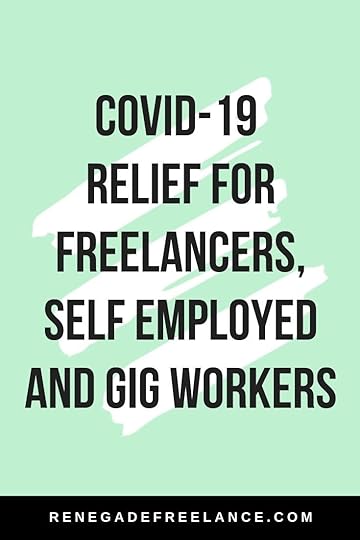
The Ultimate List of Funding Resources for Freelancers Affected By Coronavirus
This page will be updated as new information becomes available. Please be patient!
The $2 trillion coronavirus stimulus package will put money in the hands of Americans through unemplyment, stimulus checks, grants and loans.
Most adult Americans can expect stimulus checks of $1,200 (or more if they have children).
Beyond stimulus checks, self-employed individuals, freelancers and gig workers also now qualify for unemployment benefits through their local state unemployment offices. Even those who have lost partial income or cannot start a new job due to the virus should now qualify for benefits, and the typical requirement of having to apply to jobs while receiving benefits is currently being waived.
How much you recieve depends on your state, but the federal government is now supplying up to $600 additional per week on top of the standard state payouts.
The new laws also include policies to help students pause their loan payments, mortgage forgiveness and a freeze on evictions.
For more detailes, please see these FAQs answered by the New York Times.
The SBA (Small Business Administration)EIDL Loan AdvanceThis advance will provide $10,000 in economic relief to businesses that are currently experiencing a temporary loss of revenue and the loan advance will not have to be repaid.
Apply for the EIDL loan here.
This loan is designed to provide a direct incentive for small businesses to keep their workers on the payroll. Even though it’s defined as a loan, SBA will FORGIVE repayment all employees are kept on the payroll for eight weeks and the money is used for payroll, rent, mortgage interest, or utilities.
Apply for the Paycheck Protection Program here.
PatreonWhat The FundIf you’re not familiar with Patreon, it’s a crowdfunding solution (similar to Kickstarter) that allows fans to support creators with subscription-based recuring donations. The grant program is open to any creator, anywhere in the world, who is being demonstrably impacted by the COVID-19 situation
Freelancers UnionFreelancers Relief FundFreelancers Relief Fund will offer financial assistance of up to $1,000 per freelance household to cover lost income and essential expenses not covered by government relief programs, including food, utilities and cash assistance due to income loss.
Apply to the Freelancers Relief Fund here.
Covid - 19 Freelance Artist ResourcesThis crowd-sources list includes a full list emergency funding options in addition to discounted mental-health resources and more.
Additional ResourcesThis blog post will be updated as new information becomes available. In the meantime, the following list should provide a starting place for your own information gathering. Make sure to check for relief options at the federal, state and county levels.
Your State Unemployment Office (Department of Labor)
Consumer Finance Protection Bureau
To be continued…. please check back! If you have any extra resources please leave them in the comments.
January 26, 2020
How To Write A Winning Upwork Proposal
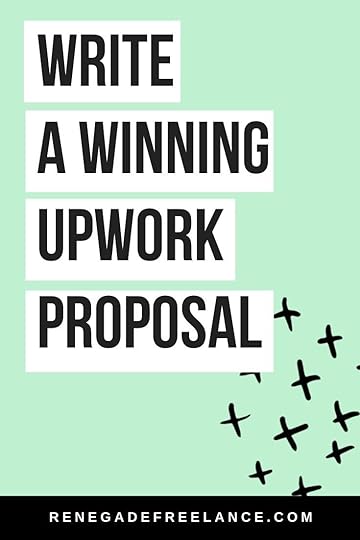
How To Write A Winning
Upwork Proposal
Once you’ve got your Upwork profile ready to go, the next step it to craft a winning proposal that will get your hired. Here are my tips on writing a winning proposal!
Start with a template.If you’ve ever used Upwork as a client, you know that an overwhelming number of freelancers use canned responses.
It can be painfully obvious to clients when a freelancer simply copies and pastes the same proposal into every available job. While I don’t this, I do recommend something similar.
Pre-written templates will save you a ton of time when submitting proposals, and it has been one of the keys to my success on Upwork. Within about half an hour I can be done applying to all the relevant jobs and get on with my day.
Personalize it.While Upwork will not show you the client’s name within the job post, you can access the client’s reviews. Check to see if any past freelancers have left a review with the client’s name. If they have, update your proposal with that client’s name to grab their attention.
Match Their Wording.This is a helpful psychological trick when applying to any job. By reading the full description and using some of their vocabulary, they will be more likely to see you as a member of the team.
Focus on the Client’s Issue.Many freelancers focus on their years of expertise and training when applying to jobs, but I can guarantee you that clients don’t care. Instead, focus on exactly how you will help them.
Charge Your Rate, Not the Budget.Do not change your rate to meet the client's budget. Quite often, clients don’t know what their budget should be so they will choose a random number or whatever Upwork recommends. I recommend picking a flate rate and sticking to it.
Check for Mistakes.Use a spell checker or plugin like Grammarly to make sure there aren’t any typos before you send the final proposal.
craft A Short Intro that stands by itself.Clients are most likely to skim through your proposal without reading it all the way through so make sure the first paragraph covers your main points by itself and addresses the client and their issues quickly.
Include Examples.Very often clients will ask you for examples of past work. You should have examples in your portfolio but many clients will not take the extra step to get to that section of your profile. You can skip a lot of extra questions and grab the client’s attention by including examples directly in your proposal.
Include Turn Around Time.Clients always want to know how much a project will cost and how long it will take. Make sure you give an estimate of turnaround time so they can better compare your proposal to others or estimate the final cost of the project.
Give Free Advice.I always give my clients a free audit to build trust and make sure we're a good fit. By recording my screen and voice while reviewing their account and outlining my suggestions, I can start building a relationship with my clients before we ever even talk in person.
Use A Call To Action.I like to always ask the client for something because it will get them to start interacting with me and building a relationship. I usually end up asking for a link to the client’s social media account because it's usually not included in the job post and it gives me the information I need to record and send an audit.
Set Up An Interview.If a client likes your proposal the next step is usually an interview. I am often able to avoid this step by recording a free audit of their social media account with recommendations. For anyone who still wants an interview, I send them a link to my online scheduler (I use Calendly) instead of doing the interview right away. This shows them that my time is valuable and that I am in demand.
Tell them you’re new to Upwork, but not new.If you don't have any reviews yet read how to get your first Upwork reivew. You can also tell them that even though you're new to Upwork you are not new to the industry. As an alternative, you can include recommendation letters from past employers, examples of success stories, or you can offer them a discount while you grow your portfolio.
Read the job description.Make sure you read the job description from beginning to end. Many clients include code words or extra questions in their posts to make sure you read it properly.
Be Thorough.Some jobs will ask you to answer the additional question beyond just the cover letter. When applying to jobs, these questions will show up underneath the cover lover section but when the client is viewing your proposal, they show up in the opposite order. I'm important to consider that the client will read the answers to the extra questions before your cover letter when answering them since they will show up first for the client.
Use search filters.Upwork includes search filters for the country, budget, number of proposals and payment verification. These are all great ways to make sure you’re applying to the highest quality job posts.
Be selective and look for red flags.It's never worth the money to work for a bad client because a bad review can make it very difficult to get any future jobs on the platform. Be careful to screen clients by looking for past reviews and be wary of anyone who is demanding or treats you like an employee. Also, be aware of clients to ask for free work.
Look for recently posted jobs without too much competition.If you’re having trouble finding jobs you may have too much competition. Try looking at the most recently posted jobs because fewer freelancers will have had a chance to apply. You can also use the search filters to find jobs with fewer proposals. The sooner you apply to a new job the more likely you are to get hired, so also make sure you check for new jobs every day. If you’re still struggling, check for new jobs multiple times a day or on the weekend.
Choose a NicheIf you niche your services down and choose a specialty to focus on, you will be competing with a smaller pool of talent. For example, there is more competition for “social media” jobs than for Instagram or Facebook, specifically.
Research their businessClients don't always reveal their business in the job posting but if they do, try to find their website or social media channels and research their business when applying. By referring to their business in detail you will stand out among other freelancers.
Include references or testimonialsMany clients will ask for examples of your past work. Even if you’ve already included these in your profile, eliminate these extra steps and cut to the chase by including references and testimonials directly in your cover letter.
Have A Winning ProfileA great profile will give your proposals an extra edge over your competition. Read how to create a winning profile here.
How To Craft A Winning Upwork Profile

How To Craft A
Winning Upwork Profile
A well-crafted profile is an important key to the Upwork puzzle. By optimizing the keywords in your title and overview, you can increase your chances of being found by potential clients.
Here are my top tips for a profile that attracts more clients!
Verify Your Account.When you first sign up for Upwork, they will send you a confirmation email to verify your account. From there, most freelancers are asked to complete a short interview as a means to verify their identity. I recommend starting with a client account and then adding a freelancer account to it.
View other profiles in your niche.By creating a client account you can view other freelancers in your niche. Take note of what keywords they’re using in their titles and try to include as many as possible. For example, if you want to offer social media services, you might notice that some of the other freelancer titles include “social media management” and others include “social media marketing”. Think about including both of these terms in your profile or overview to show up in searches for both terms.
You can also use the search filters to look for the highest-rated and highest-earning freelancers. I like to read the overviews for all the top freelancers in my industry because it gives me great ideas for what my overview should include. I don’t recommend copying anyone’s text, but it can be helpful to make a list of things you notice. For example, maybe they’re including testimonials or an FAQ.
Pick a specialty.I very strongly recommend going niche, especially when starting. For example, if I go on Upwork and search for social media managers in the US, I get almost 12,000 results. However, if I narrow that search and instead look for Instagram experts, the results go down to just 400. It is far better to compete with 400 other experts than 12,000, but going niche has other benefits too. By offering just one service, you can streamline your service into an easy to follow template that can be repeated for every client. It will also make it easy to train assistants if your business becomes large enough to start outsourcing.
Pick A Good Profile Photo.Don’t get stuck on this part. You need a decent photo on your profile, but it doesn’t have to be a professional headshot. Just make sure the photo is clear and that you’re smiling without hiding any of your face.
Complete Your Profile.A complete profile will help Upwork and potential clients to view you as a professional. By being thorough, you will also keep viewers on your page longer which will help make a more permanent impression in their minds when deciding who to hire.
Title. Use your keyword research to craft a compelling, niche-specific title. I recommend using up all the space that you can while still making sure your title reads well
Overview. This is the meat of your profile. A lot of freelancers make the mistake of talking about all their experience here, but I recommend focusing on the client and how you can help them. Think of it as an extension of your cover letter and include the types of clients you work with, how you work, why your specialty is helpful to people, what your services include and past success stories. Save your credentials and education history for other parts of your profile.
Hourly Rate. This is another instance where I would use a client account to do some research and compare what other freelancers are charging. A low rate will make people value your work less and will attract high maintenance, difficult clients. Charging higher will make them value and respect you more. Clients who pay higher rates are also usually more invested in getting you what you need to complete the job. Keep in mind that you can change your profile rates at any time and you can choose a custom price for every job you apply to.
Portfolio. Your portfolio is a great place to highlight past work, and it allows you to add a title, completion date, deliverables, a description, a URL and photos for each project. You don’t have to be too detailed here, but you do want to make sure you include some kind of title, a brief description and especially an image. If you leave the image field blank, Upwork will show an empty box where the image should be, which tends to look unprofessional. Try to include at least 4 examples because those will show up on the first page of your portfolio.
Skills. This is another way to optimize your profile for searches. You can think of them as categories or tags that you add to your profile from a menu provided by Upwork. Make sure you pick all the skills you can find related to your niche. From there, I would go broader if you have extra room.
Employment History. This section is more like a resume where you can list past work. I recommend focusing on the skills related to your freelancing more than the company itself or your formal title, especially if it’s unrelated to your freelancing work.
Education. This section is where you can add formal education including the name of the school, dates, degree, area of study and any extra details. Don’t get too stuck on this part- most clients are more concerned with your pitch and profile overview.
Other Experiences. This is a great place to add any non-formal education including online courses.
Languages. One big pain-point from a client’s perspective is freelancers claiming to be fluent in a language like English when they are not. Include any languages you know, but be honest about your level of experience in them.
Make changes. Your profile is not set in stone, and it should not take that long to complete. Many freelancers get stuck on minute details here instead of getting it done and moving on. Your profile should not take more than a day to complete, just get it done and remember that you can make changes later if you need to.
Consider adding a video. I prefer to send my clients screen recordings in a private message after starting a conversation, but many freelancers include a video in their profile and that can be another great option. By including a video you increase your trust factor, confirm your language fluency and show that you’re a good communicator.
January 25, 2020
How To Get Your First Upwork Review
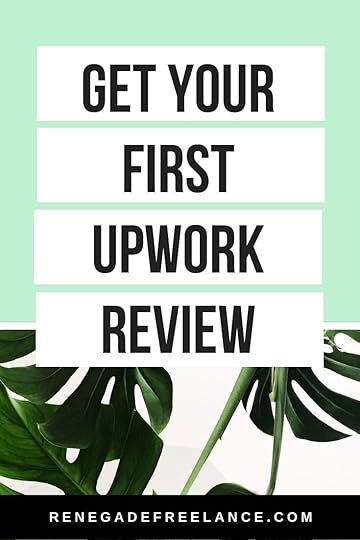
How to get your First
Upwork Review
A high job success score and good reviews are key to being successful on Upwork. Your Upwork clients will be able to leave you feedback which will affect an overall success score. This feedback will show up on your public profile for other potential clients to read, so it’s very important to maintain good feedback and a high score. Upwork also allows clients to prioritize their search for freelancers with success scores over 80 and 90%, so keeping your score over 80 is essential.
Craft a great portfolio.Make sure you have a portfolio with photos or screenshots and details about past work. If you don’t have any history freelancing, that’s ok. Use examples from school or past jobs and anything else that could be relevant. This will show them that even though you are new to Upwork, you do have relevant experience.
Tell them you’re new to Upwork.Reviews are one of the top ways that clients choose who to work with. If you don’t have any reviews they are likely to decline your proposal, especially if you don’t explain why. Just telling clients that you’re new to Upwork, but not the industry can go a long way in being considered. You can also take things a step further by showing them examples of past work directly in your proposal, in addition to testimonials or recommendation letters from past jobs or internships.
Don’t accept any less than five stars.Once you finally get your first job, you will want to make sure you get excellent feedback when the job is complete. When you’re ready to submit your work, tell your client you want to make any changes they need until they are 100% happy with the results. This will help ensure that the client will not close the contract until they are completely satisfied with the work.
Ask for feedback.Sometimes a client will close a contract and forget to leave you a review. A gentle reminder can go a long way in making sure they leave you great feedback. Here’s an example of what you can say.
“If there’s no further work to be done, I’d appreciate it if you could leave me a review! It would help me secure further work. I want to guarantee the satisfaction of my clients and hold myself to a high standard, so if you don’t feel the work I submitted meets a 5-star rating, please let me know and I’ll do everything I can to fix that.”
Give a refund.This should be a last resort, but sometimes you will just end up with a client who was a bad fit, and occasionally bad reviews can happen. If you have a bad review that causes your job success score to drop below 80%, I would recommend giving the client a refund. This won’t change your success score but it allows you to remove their remarks from your profile.
Make sure the client has good reviews.There are good and bad clients in Upwork. Luckily, Upwork allows freelancers to review clients and bad client reviews can be a good sign that someone is difficult to work with. Make sure you work with high-quality clients to avoid those who are impossible to please, and you will be more likely to have a happy client who will leave a nice review for you.
Look for small, short term jobs.You will not be able to collect reviews until your work is complete, so the sooner the job is finished, the sooner you can get a review. If you prefer to work on long-term projects, ask your clients to start with a 1 week or 1 month trial. That way you can close the contract, collect your review, and then re-start a longer contract with the same client.
Work for someone you know.See if a friend, a neighbor or employer has any work you can help them with, and get them to hire you through the Upwork platform by creating a private job and inviting you to it. Only do this authentically and treat it just like any other job.
Offer a discount.I don’t generally recommend lowering your prices, but if you’re struggling to get reviews you may want to make an exception. Tell them that since you are new to Upwork, you are offering your services at a discounted rate for a limited amount of time.
Close the contract.Make sure you close the contract. Open or paused contracts cannot receive reviews.
January 23, 2020
How To Get Your Upwork Profile Approved
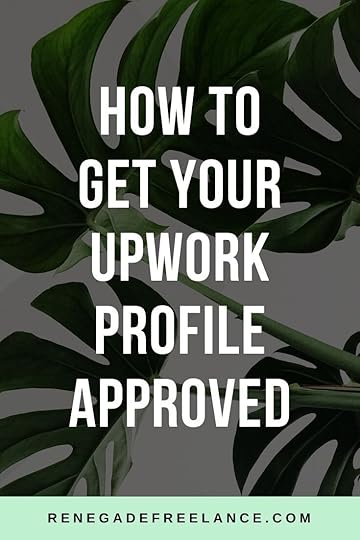
How To Get Your Upwork Profile Approved
According to CEO Stephane Kasriel, Upwork gets 10,000 new signups EVERY DAY. As the platform has grown, Upwork has started screening their applicants more closely and many first time freelancers have trouble getting their profile approved.
In some ways, this screening practice is a good thing because it helps keep out unqualified freelancers from competing with you and driving away potential clients with poor quality work. But on the other hand, it can be incredibly frustrating for trustworthy professionals who can’t seem to access people they know they can help.
It’s important to remember that when Upwork rejects a profile, they usually have a reason. If you take the time to figure out what Upwork is looking for and why, you can boost your chances of getting approved.
Upwork is the biggest freelancing platform out there and it can be invaluable to your freelance business so don’t give up after one rejection. Try making some changes and re-submitting your profile.
Here are some things to try:
Use a business email address.By using a business email address, Upwork is more likely to view you as a serious professional. A business email is one that ends in a custom domain name, like instead of a Gmail or similar address. You can get a business email through google or your domain host. https://gsuite.google.com/products/gmail/
Diversify.In general, I advise freelancers to pick a small niche once their on the platform, but if you’re having trouble getting approved try diversifying your profile with a wider range of skills.
Upwork tries to control the supply and demand by limiting the number of freelancers across different categories, so you can increase your chances of getting approved by adding extra skills that might have lower competition or more demand. You can always niche down your profile after you get through the approval process. Think about how your skills can overlap genuinely and if you need ideas, check the profiles of other freelancers in your field by creating a client account.
Choose the right Experience Level.Upwork will ask if your experience level is beginner, intermediate or advanced. Most freelancers underestimate themselves and choose an experience level below their actual skill level. Think about how your experience could qualify you as an intermediate or advanced freelancer. Don’t forget about education and volunteer work. You don’t need experience freelancing, specifically.
Write A Good Title.Try not to be too vague or too specific with your title. You want something descriptive, without pigeon-holing yourself too much. Create a client account to view other freelancer’s titles for ideas.
Complete your profile.Your Upwork profile includes many sections such as a profile photo, work history, and a portfolio. Upwork doesn’t want people who take shortcuts so be sure to include work, volunteer, non-formal education, social media accounts and anything else that can give your profile a boost.
Make sure you include as much detail as possible in each section so that Upwork sees you as a serious professional. Also make sure you have a good profile photo that is easy to see without hiding any of your faces.
Get Invited To A Job.If all else fails, you can try having a friend, neighbor or co-worker set up a private job on Upwork and email you an invitation to apply. I don’t recommend doing this unless you genuinely intend to provide some kind of service and treating it like any other job.
Get Invited To An Agency.Besides independent freelancers, Upwork also has agencies where groups of freelancers can work together under one umbrella. Agency owners can invite other freelancers to join them by sending an email invitation. Again, make sure you are operating authentically because you don’t want to risk Upwork shutting down your account. Once you’re a member of an agency, you can work under their umbrella or as an independent agent, or both.
Add Freelancer Profile to Client Account.I’m not sure if this still works, but it’s how I was able to create my freelancer account. It’s actually against Upwork’s policies to have multiple accounts with different logins, so technically, if you already have a client account, you should be doing things this way anyway. You would start by first signing up as a client. Once you have that account set up, you can add a freelancer account to it and then switch between the two within the platform. Here’s the link to the instructions: https://support.upwork.com/hc/en-us/articles/211067558-Be-a-Client-and-a-Freelancer?flash_digest=923e7297be921a112020d9e6854f4d7647a55222
January 21, 2020
How I Made Over 100K Freelancing on upwork
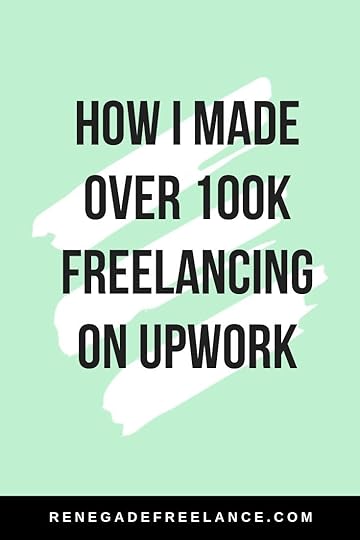
How I Made Over $100,000
In One Year On Upwork
I was living paycheck to paycheck, working 12 hours per day when I decided to quit my job several years ago. I had a loose plan, but no way of knowing if I would make any money because I was working so hard I didn’t have time to test my idea. I figured; “If I’m going to work this hard and still be this broke, then I would rather be poor working for myself than help someone else get rich”.
I struggled my first year as a Google Trusted Photographer, but it didn’t generate the income I needed because I had to do all the sales and marketing, and I wasn’t getting any leads because no one knew what street view tours were. No one was searching for Google Photographers, which made it a really tough thing to sell. That job taught me a lot of hard lessons including the incredible value of a warm lead.
I struggled for several more years after that, barely scraping by. I studied and tested just about every online business or passive income stream out there and I still wasn’t having the best luck. Through that process, I learned pretty much everything there is to know about online marketing and that lead to my first jobs subcontracting as a virtual assistant. I was finally working for myself, online, from anywhere I wanted. Through those jobs, I got an inside look at other online businesses that were already successful and making money. That’s when things started turning around for me because I got to see for myself what worked well, and what I would do differently.
After about a year of working as a virtual assistant, I was finding the almost daily meetings to be an incredible hindrance. The constant, middle-of-the-day interruptions slowed down my workflow, distracted me from my projects and kept me from exploring too far from a screen or wifi. Finally, I decided to take all of my experience and leave my life of subcontracting behind by seeking out my marketing clients.
The only problem was, how was I going to find clients?
I believed all the negative comments I heard about Upwork. That it was too competitive, that the clients were too cheap and that it was a waste of my time. But I had already exhausted almost every other option so I decided to try it anyway.
My first problem was that I knew no one would hire me without a review, but I couldn’t get a review without getting hired. So I reached out to some other business owners I knew to see if any of them needed marketing work done and if they would be willing to hire me through Upwork. Thankfully, one of them was happy to hire me and that one review opened the window to the life I had been trying to build for years; making a comfortable full-time income working for myself, from anywhere and on my schedule.
That first review changed everything. From there, the clients just kept coming. Within 4 months I had my first $1,000 month and I was onboarding clients at a rate of about 1 per week. Overall, I have averaged $6,900 per month, working less than a 4-hour workweek with the help of a team and an assistant who now does my meetings for me.
Upwork has been a complete game-changer for me, and it’s allowed me to travel for months at a time, buy a campervan, upgrade to professional camera gear, see friends and family whenever I like and start saving for retirement through practically passive income. AND, I did it without any blogging, networking, cold calling, social media posts, email lists, or a website.
That’s how valuable a warm lead from Upwork can be.
Yes there are lower priced Freelancers on Upwork and YES Upwork does charge high fees but in my opinion, none of that should matter enough to stop you. If you want a successful online business the most important thing that you need to make real money is warm leads. So just think of Upwork as your commission-only salesperson. You only have to pay them when you make money and in my opinion, that's a pretty good deal.
Here’s How I Mastered The Art Of Upwork.
I created a client account.I had already hired assistants on Upwork before, so I knew what it was like to use Upwork from the client’s viewpoint. I already knew my way around the site and I knew that most freelancers submit pretty awful proposals, they quote hourly rates without an overall cost for the project, and they don’t give estimated turn-around times, so I committed to removing those pain points for my clients. Having a client account also let me search for other freelancers in my niche and analyze their profiles.
I picked a niche.After working as a virtual assistant and a photographer I already had a ton of experience in social media marketing, but by going niche and focusing on just one social media channel (Pinterest), I was able to eliminate most of the competition down to just a few other experts. That increased my chance of being hired and being invited to jobs.
I analyzed the competition.I looked at the other experts in my niche and I combed through their profiles. I paid extra attention to any social media strategies they mentioned and added them to a list of deliverables I would be sure to include in my service. I also took note of what all the same freelancers in my country were charging so I knew how to price myself.
I took the best course I could related to my service.I assumed that I already knew pretty much everything there was to know about social media, but I wanted my service to include every single thing my competition was offering. So I invested in the best course I could find on my niche and took notes to make sure I was covering every single possible strategy for my clients.
I productized my service.Here’s the thing about projects from a client’s perspective. They don’t care what your hourly rate is as much as what the finished project is going to cost them. If you charge twice as much per hour but finish the job twice as fast, the hourly rate doesn’t really matter.
Clients just want to know how much the finished project is going to cost them and how quickly it will be done.
So after I was done analyzing the competition and taking courses on my niche, I created a standard package at a flat weekly rate. The client was paying a clear price for deliverables that I already outlined, which they loved. I recommend all freelancers outline their deliverables this way because otherwise, you can end up defending what you did all week and wasting time reassuring clients when you could be growing your business instead.
I made recurring income.Another key thing I did was to make sure my service would be recurring. By charging a weekly management rate for my packages, my income became fairly consistent. My client numbers generally fluctuated around 12, but it never affected me too much because I was charging smaller amounts every week across multiple clients. The other great thing about Upwork is that it also works as your payment processor. All of my projects were set up so I could charge the clients automatically each week, without having to chase down late or missing payments.
I outsourced.I treated my early Upwork jobs as learning experiences to help me perfect systems and develop training materials. I used common questions to develop a welcome packet and FAQ for future clients. I used problems to develop new terms for my client agreement form. As I completed deliverables, I recorded my screen to show assistants how to repeat the process. From there I grew from one hourly assistant to 3, allowing me to focus on growing the business and starting other projects.
September 12, 2019
The Ultimate List Of Resources For Digital Nomads
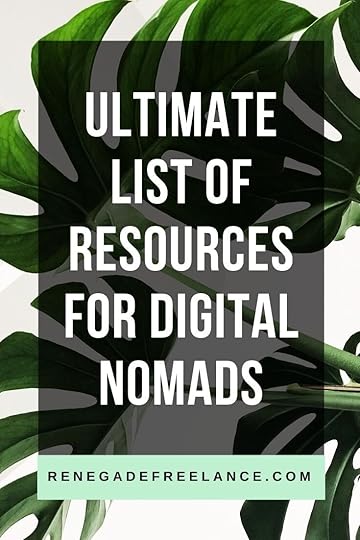
THE ULTIMATE LIST OF RESOURCES
FOR DIGITAL NOMADSWhere To Find Jobs
CoolWorks: Seasonal jobs in the great outdoors
Upwork: A global freelancing platform connecting freelancers with clients
RemoteOK: Remote job board
Free Room and BoardCoolWorks: Seasonal jobs in the great outdoors
Wwoofing: Homestays on organic farms
Workaway: Homestays and cultural exchange
Free TravelFindaCrew: Network matching boat owners with sailing crew
CouchSurfing: Stay with locals and meet other travelers
Make Extra MoneyAirBnB: Rent out your home or extra room
AirBnB Experiences: Host local tours
Outdoorsy: Rent our your campervan
Turo: Rent out your car
Learn A SkillLynda: Online business, design & tech courses
Udemy: The world’s largest online learning platform
SkillShare: Online learning through educational videos



